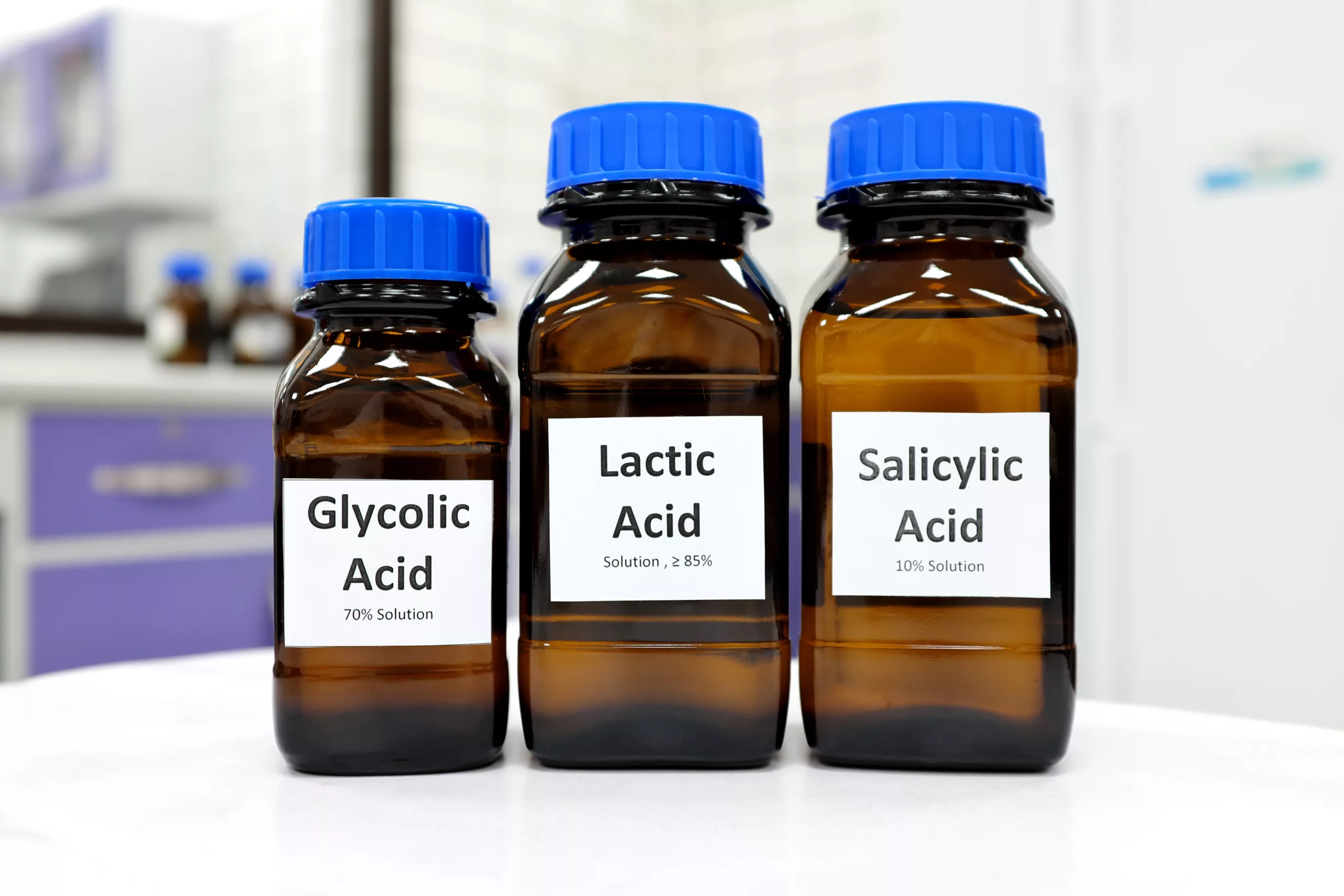
What Is Glycolic Acid? Discover its Benefits for Your Skin in this post. Glycolic acid, a prominent member of the alpha hydroxy acid (AHA) family, has garnered attention in the skincare realm for its remarkable benefits in improving skin texture, tone, and overall appearance. As a reputable medspa in Las Vegas, we understand the significance of shedding light on the nuances of glycolic acid, such as its uses, advantages, potential risks, and incorporation into effective skincare routines.
- What Is Glycolic Acid?
- Benefits of Glycolic Acid for Skin
- Enhanced Exfoliation and Cell Turnover
- Improved Skin Tone and Texture
- Reduction of Acne and Breakouts
- Increased Hydration and Moisture Retention
- Collagen Production Stimulation
- Versatility and Compatibility With Other Skincare Ingredients
- Better Absorption of Skincare Products
- Potential Anti-Aging Properties
- Customizable Concentrations for Different Skin Types
- Suitability for Different Skin Types
- Incorporating Glycolic Acid Into Your Skincare Routine
- Potential Side Effects and Precautions
- Safety Concerns Regarding Daily Use
- Contact RAREV for Glycolic Acid Treatments
What Is Glycolic Acid?
Before we discuss how glycolic acid is beneficial for your skin, let’s dive deeper into what glycolic acid is.
Chemical Composition and Action on Skin
Glycolic acid, derived from sugarcane, exhibits a small molecular structure allowing for effective penetration into the skin. It functions by loosening the bonds between skin cells, promoting exfoliation, and encouraging the shedding of dead skin cells, unveiling a fresher, smoother complexion underneath.
Variety of Glycolic Acid Products and Available Treatments
Glycolic acid is available in various skincare products, such as cleansers, toners, serums, and creams. Its potency varies across products, with professional masks and chemical peels offering higher concentrations suitable for deeper exfoliation and rejuvenation.
Benefits of Glycolic Acid for Skin
As a reputable component of various skincare products and treatments, glycolic- acid offers a plethora of advantages that contribute to achieving healthier, more radiant skin. Below are some notable benefits of glycolic acid for skin health.
Enhanced Exfoliation and Cell Turnover
Glycolic-acid works as an excellent exfoliant, aiding in the removal of dead skin cells that accumulate on the skin’s surface. By effectively exfoliating the outer layer, it stimulates cell turnover, revealing fresher, younger-looking skin underneath. This process helps diminish the appearance of fine lines, wrinkles, and uneven texture, resulting in a smoother complexion.
Improved Skin Tone and Texture
Regular use of glycolic- acid can assist in refining skin texture and evening out skin tone. It aids in reducing the visibility of hyperpigmentation, dark spots, and acne scars, leading to a more uniform and radiant complexion.
Reduction of Acne and Breakouts
Glycolic acid’s exfoliating properties unclog pores, preventing the formation of acne, blackheads, and whiteheads. By keeping pores clear, it minimizes the likelihood of breakouts and helps in managing acne-prone skin.
Increased Hydration and Moisture Retention
Contrary to common belief, glycolic-acid can actually enhance skin hydration when used in appropriate concentrations. This substance assists in improving the skin’s moisture-retaining abilities, contributing to a plumper and more supple appearance.
Collagen Production Stimulation
Additionally, regular application of glycolic-acid can stimulate collagen production in the skin. Collagen is crucial for maintaining skin elasticity, firmness, and youthfulness. Since glycolic acid aids in collagen synthesis, it can help diminish the appearance of fine lines and wrinkles over time.
Versatility and Compatibility With Other Skincare Ingredients
Glycolic-acid is versatile and easy to integrate into various skincare routines. Moreover, glycolic acid complements other skincare ingredients and treatments — such as hyaluronic acid, vitamin C, niacinamide, and sunscreens — allowing for combination approaches to address multiple skin concerns effectively.
Better Absorption of Skincare Products
By exfoliating the skin’s surface, glycolic-acid enhances the penetration and absorption of other skincare products, maximizing their efficacy. This characteristic makes it an excellent addition to skincare routines, allowing for better utilization of serums, moisturizers, and other treatments.
Potential Anti-Aging Properties
Its ability to encourage cell turnover, boost collagen production, and improve skin texture contributes to glycolic acid’s potential anti-aging effects, aiding in maintaining youthful-looking skin.
Customizable Concentrations for Different Skin Types
Glycolic-acid products come in various concentrations, making them adaptable for different skin types. Lower concentrations are suitable for sensitive skin, while higher concentrations cater to those who can tolerate more potent formulations.
Suitability for Different Skin Types
Glycolic acid is generally well-tolerated by various skin types, but its efficacy might differ.
Normal Skin
Generally, individuals with normal skin types can tolerate glycolic-acid well. They can benefit from glycolic acid’s exfoliating properties without experiencing excessive dryness or sensitivity.
Dry Skin
Glycolic-acid may pose a risk of further drying out already parched skin due to its exfoliating nature. However, when used cautiously and paired with hydrating ingredients, it can aid in removing dry, flaky skin and improving moisture retention.
Oily/Acne-Prone Skin
Glycolic-acid is particularly beneficial for oily or acne-prone skin. Its exfoliating properties unclog pores, reduce excess oil, and help in managing acne by preventing pore blockages.
Combination Skin
People with combination skin can benefit from glycolic acid’s ability to balance oiliness in the T-zone while providing gentle exfoliation for drier areas.
Sensitive Skin
Individuals with sensitive skin should approach glycolic-acid cautiously due to its potential to cause irritation or redness. Higher concentrations may be too harsh for sensitive skin types.
Incorporating Glycolic Acid Into Your Skincare Routine
If you are interested in incorporating this ingredient into your skincare routine, here are some factors you need to keep in mind:
- Frequency and Application: Gradually introduce glycolic acid into your routine to allow skin adaptation. Begin with a lower concentration, applying it two to three times a week, gradually increasing as your skin adjusts.
- Time of Day: Apply in the evening, post-cleansing, and always follow up with sunscreen during the day due to increased sensitivity to UV rays.
- Amount: A pea-sized amount is sufficient for the face, just gently massage it into the skin until absorbed.
Potential Side Effects and Precautions
While glycolic is generally safe, potential side effects include mild irritation, redness, and increased sun sensitivity. Patch testing and starting with lower concentrations can mitigate these adverse reactions.
Additionally, individuals using glycolic acid should abstain from using other exfoliating agents simultaneously to prevent over-exfoliation and irritation.
Safety Concerns Regarding Daily Use
Using glycolic acid daily might be suitable for some individuals with higher tolerance levels, but it’s crucial to monitor skin reactions. For most, incorporating it two to three times per week initially and gradually increasing frequency is best.
Contact RAREV for Glycolic Acid Treatments
Glycolic acid is a versatile and effective skincare ingredient, catering to diverse skin concerns. Understanding its potency, incorporating it judiciously, and considering individual skin types are essential for reaping its myriad benefits without adverse effects. For tailored skincare advice and professional guidance, consider consulting our chemical peel experts at RAREV for a personalized skincare regimen.
As your dedicated skincare ally, we emphasize the significance of informed decisions and proper skincare practices for achieving optimal skin health and radiance.

